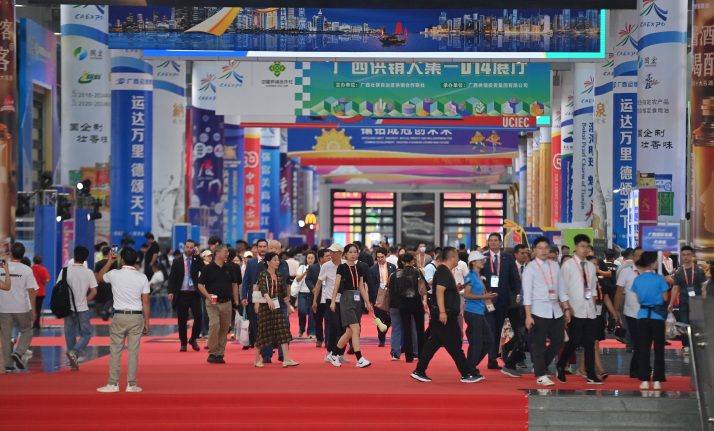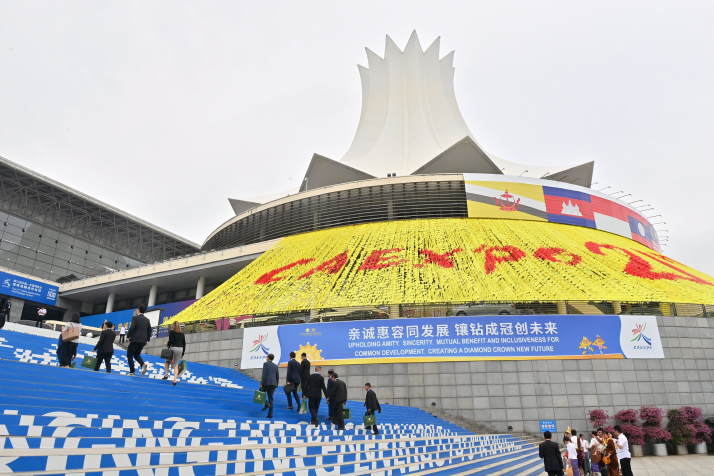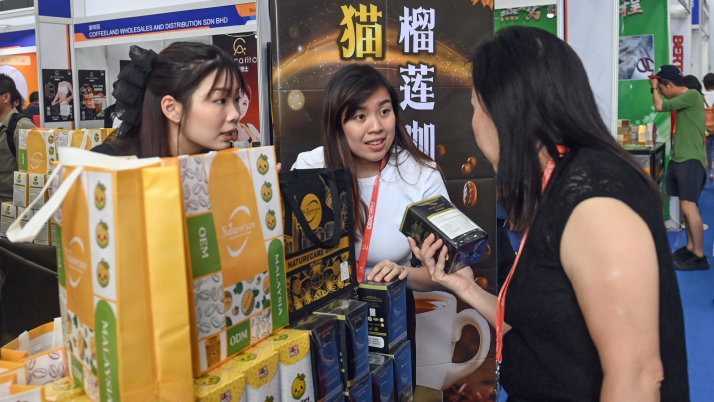| World |
| Closer China-ASEAN cooperation boosts regional high-quality development | |
|
|
 Visitors at the 21st China-ASEAN Expo (CAEXPO) in Nanning, Guangxi Zhuang Autonomous Region, on September 24(XINHUA)
Viet Nam's aromatic Trung Nguyen coffee, Malaysia's Musang King durian, Thailand's fragrant jasmine rice and Laos' refreshing beer—what do they all have in common? The answer is they've all made an entrance into the vast Chinese market through the China-ASEAN Expo (CAEXPO), earning rave reviews from delighted consumers. ASEAN is the abbreviation of the Association of Southeast Asian Nations, a 10-member geopolitical and economic organization of countries in the region. On September 24, the 21st CAEXPO and China-ASEAN Business and Investment Summit kicked off in Nanning, Guangxi Zhuang Autonomous Region. Like a foodie's fantasy come true and a business bonanza wrapped into one, the expo promised not just to tantalize taste buds but also to turbocharge trade ties between China and its Southeast Asian neighbors. In addressing the opening ceremony, Chinese Vice Premier Ding Xuexiang said interactions between China and ASEAN have served as the most successful and dynamic model of cooperation in the Asia-Pacific region, and are a vivid example of the building of a community with a shared future for humanity. He met with Deputy Prime Minister and Minister of Finance of Viet Nam Ho Duc Phoc, Deputy Prime Minister and Minister in charge of the Office of the Council of Ministers of Cambodia Vongsey Vissoth and Deputy Prime Minister of Laos Kikeo Khaykhamphithoune, who were in Nanning to attend the 21st CAEXPO and the China-ASEAN Business and Investment Summit. Ding is also a member of the Standing Committee of the Political Bureau of the Communist Party of China Central Committee. Along with the flourishing ties, the expo has become an important supplement to the 10 Plus One cooperation framework between China and ASEAN, providing strong support for regional high-quality development, Luo Yongkun, Deputy Director of the Institute of Southeast Asia and Oceania Studies at the China Institutes of Contemporary International Relations, told Beijing Review. The expo has been standing as a testament to the enduring friendship, cooperation and shared prosperity between China and ASEAN countries over the years, Kao Kim Hourn, Secretary General of ASEAN, said at the opening ceremony, adding that since its inception in 2004, the event has evolved into an important platform for dialogue, cooperation and development, covering sectors such as infrastructure, agriculture, technology, education and tourism.  The Nanning International Convention and Exhibition Center, the venue of the CAEXPO, in Nanning on September 24(XINHUA)
Fruitful results In October 2013, Chinese President Xi Jinping proposed that China and ASEAN countries work together to build the 21st-Century Maritime Silk Road and foster a closer China-ASEAN community with a shared future. The China-proposed Belt and Road Initiative (BRI), consisting of the Silk Road Economic Belt and the 21st-Century Maritime Silk Road, aims to boost connectivity along and beyond the ancient Silk Road routes. "China considers ASEAN a priority in its neighborhood diplomacy and a key region in high-quality Belt and Road cooperation," Ding said. "ASEAN countries, on their part, see in China a trustworthy and close partner." The shared values of peace, cooperation and mutual respect between China and ASEAN form the foundation of their partnership, Vongsey Vissoth, Deputy Prime Minister of Cambodia, said, adding he believes that the two sides can achieve more fruitful results through their cooperation in trade and economy, with the China-ASEAN Free Trade Area bringing new opportunities, according to a China Daily report. China has been ASEAN's largest trading partner for 15 consecutive years, while ASEAN has been China's top trading partner since 2020. The cumulative two-way investment has exceeded $400 billion, according to China's Ministry of Commerce. In the first seven months of this year, bilateral trade reached $552 billion, up 7.7 percent year on year. In a video speech delivered at the opening ceremony, Malaysian Prime Minister Anwar Ibrahim said China is an important trading partner of Malaysia, and it is vital for ASEAN and China to diversify trade and investment strategies. Stepping into the Thai Pavilion at this year's CAEXPO, visitors were immediately enveloped by the unmistakable aroma of durian, mingling with the distinctive herbal scent of Zam-Buk balm. One booth, in particular, capturing attention, showcased the partnership between Thailand's government-led TOPTHAI program and China's e-commerce giant JD.com. Opening TOPTHAI stores on globally leading e-commerce platforms is a new initiative launched earlier this year by the Thai Department of International Trade Promotion. This effort aims to assist Thai small and medium-sized enterprises (SMEs) in reaching a broader international audience, with the Chinese market being a key target. The initiative is pivotal for enhancing the global presence of Thai products, Nisachol Thaithong, a Thai trader and researcher specializing in China-Thailand cross-border e-commerce, told Xinhua News Agency. "Harnessing the strength of its super-sized market, China is ready to import more quality products from ASEAN countries," Ding said. The CAEXPO has made important contributions to the economic integration between ASEAN and China, facilitating investment flows and cross-border economic opportunities, laying the foundation for building a more connected, resilient and dynamic region, Kao said. When attending this year's CAEXPO, Vietnamese Deputy Prime Minister and Minister of Finance Ho Duc Phoc proposed four priority areas for future ASEAN-China cooperation—promoting balanced and sustainable trade, enhancing strategic connectivity and expanding regional economic corridor routes, encouraging high-quality investment in emerging sectors, and strengthening cultural and tourism exchanges. Noting that 2024 has been designated as the ASEAN-China Year of People-to-People Exchanges, Kikeo Khaykhamphithoune, Deputy Prime Minister of Laos, said the partnership between China and ASEAN is not only reflected in trade and investment, but also in culture and tourism. Laos is the rotating chair of ASEAN this year. "With continued and renewed collaboration, ASEAN and China will forge new pathways for growth and success," Kao said.  A visitor selects Malaysian coffee at the 21st CAEXPO at the Nanning International Convention and Exhibition Center in Nanning on September 24(XINHUA)
New highlights In 2010, the China-ASEAN Free Trade Area was officially launched, opening a channel for ASEAN enterprises to gain more efficient and convenient access to the Chinese market. Speaking at the opening ceremony, China's Vice Minister of Commerce Li Fei said mutually beneficial cooperation between China and ASEAN countries has reached new levels. Bilateral economic and trade cooperation has continued to upgrade over the years, with positive progress achieved in negotiations for version 3.0 of the China-ASEAN Free Trade Area, he added. As early as 2015, China and ASEAN initiated the construction of the China-ASEAN Information Harbor to cultivate new drivers of economic development. Today, nearly 20 projects across nine ASEAN countries in fields such as digital government, digital industries and new communications have been conducted under the framework, Luo said. "We need to leverage the harbor to promote digital connectivity and information sharing, and work for a digital Silk Road," Ding said in his speech. At this year's CAEXPO, a new section was conducted to highlight strategic emerging industries, showcasing the latest progresses and technologies in fields such as digital technology, new energy and intelligent connected vehicles. For instance, visitors were dazzled by a variety of China-made unmanned aerial vehicles (UAVs). The products' intelligent solutions for modern agriculture and emergency rescue attracted the attention of ASEAN buyers. "Brunei's agriculture is moving toward modernization and intelligence, where UAVs can play an indispensable role in agricultural protection and monitoring. Chinese technology in this regard is advanced and cost-effective, which perfectly meets our needs," said Brunei exhibitor Eddey Neson Bin Embran. He said that by attending the CAEXPO, he hopes to find suitable partners and introduce more Chinese UAV technologies and products, thus jointly exploring the potential of the low-altitude economy, which refers to a realm of industries centered on civil manned and unmanned aerial vehicles. Leading Chinese green technology companies are also working closely with ASEAN enterprises and investing in new facilities to produce innovative and locally adapted products, contributing to ASEAN's green transition. Chinese automaker SAIC-GM-Wuling Automobile Co. Ltd., a long-term exhibitor at the CAEXPO, has established a factory in Indonesia to produce electric vehicles (EVs). In the first half of this year, Wuling held a 68.4-percent share in Indonesia's EV market, according to the company. In July, leading Chinese EV maker BYD inaugurated its first Southeast Asian EV plant in Thailand, tapping into the region's rapidly expanding market. EVE Energy, one of China's leading lithium-ion battery manufacturers, has also unveiled plans to launch a new factory in Malaysia, aiming to cater to the surging demand for energy storage and consumer batteries across the region. According to Lei Xiaohua, a researcher with the Southeast Asia Research Institute at the Guangxi Academy of Social Sciences, ASEAN countries, in addition to sources of primary products to China, currently import machinery and intermediate goods from China, and then export consumer goods back to China and third countries. However, Lei pointed that this kind of cooperation has relatively low added value and is not that robust. The two sides need to build a higher value-added industrial chain to make their bilateral cooperation more stable, he said. The ongoing efforts to advance the China-ASEAN Free Trade Area 3.0 will lead to a broader opening up in investment and services trade, Lei said, adding that the CAEXPO will be endowed with a new mission in future regional industrial and supply chain cooperation. Deepening RCEP collaboration Cooperation among Regional Comprehensive Economic Partnership (RCEP) economies will continue to flourish and create benefits for the people of the region, agreed participants at the RCEP High-Level Dialogue on Economic and Trade Cooperation on September 24. RCEP is a free trade agreement (FTA) comprising 15 Asia-Pacific countries, including the 10 ASEAN members, China, the Republic of Korea, Japan, Australia and New Zealand, making it the largest trading bloc in history. The event was held on the sidelines of the CAEXPO, during which the RCEP Regional Industrial Supply Chain Alliance Charter was announced. The charter is a key initiative to bolster cooperation in industries that are vital to the economic ecosystems of RCEP member countries, Manothong Vongsay, Vice Minister of Industry and Commerce of Laos, said. "In an era where supply chain disruptions and global uncertainties are increasingly common, this partnership will play a crucial role in ensuring the stability and sustainability of our region's economic activities," Manothong said. "By harmonizing rules of origin and reducing transaction costs, RCEP enhances the resilience of global and regional supply chains," Kao said. RCEP's role as a platform for regional cooperation has the potential to identify vulnerabilities and develop strategies to mitigate risks, Zou Ciyong, Deputy to the Director General and Managing Director of the United Nations Industrial Development Organization, said. Member countries should also invest in raising people's awareness of the partnership and support SMEs to ensure that all can adapt and seize the opportunities generated by the FTA, Zou added. Kao said with both RCEP and China-ASEAN Free Trade Area 3.0 in place, he is confident that trade and investment between ASEAN, China and other RCEP partners will continue to flourish and expand. China-ASEAN Big Events China-ASEAN cooperation has made tremendous progress over the past three decades. ● In 1991, China and ASEAN initiated the dialogue process. ● In 2002, China and ASEAN countries signed the Framework Agreement on Comprehensive Economic Cooperation, kicking off the process of building the China-ASEAN Free Trade Area (CAFTA). ● In 2003, China and ASEAN established a strategic partnership. ● In 2004, the first China-ASEAN Expo (CAEXPO) was held in Nanning, Guangxi Zhuang Autonomous Region, to boost CAFTA development and provide opportunities and platforms for economic and trade cooperation. ● In 2010, China became ASEAN's largest trading partner, with the value of bilateral trade approaching $300 billion. The CAFTA was launched that same year. ● In 2013, the year in which Chinese President Xi Jinping proposed the Belt and Road Initiative, China and ASEAN countries adopted the declaration on the China-ASEAN Port Cities Cooperation Network during the 10th CAEXPO. ● In 2020, the Regional Comprehensive Economic Partnership (RCEP), an FTA between the 10 ASEAN member states and five Asia-Pacific countries—China, Australia, Japan, New Zealand and the Republic of Korea, was signed. It is the world's largest free trade deal. ● In 2021, China and ASEAN agreed to elevate their ties to a comprehensive strategic partnership. (Print Edition Title: Exploring New Horizons) Copyedited by G.P. Wilson Comments to mamm@cicgamericas.com |
|
||||||||||||||||||||||||||||||
|